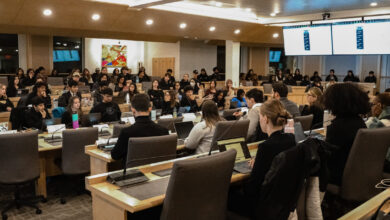Notes from Council: Coalition for Affordable Course Materials presents
The CACM presented on the First-Day Access Program, which would provide students with all required course materials for a flat, semesterly fee.
 Helen Zhang
Helen Zhang“Notes from Council” is The Gateway’s ongoing series of recaps of noteworthy items from Students’ Council meetings.
At the January 21 University of Alberta Students’ Union (UASU) Students’ Council meeting, council received a presentation from the university on online learning. Ellen Salter, assistant general manager of the UASU, outlined plans for replacing the BearsDen software.
Representatives from Club Periodically‘s Period Equity Initiative shared updates on their petition to run a dedicated fee unit (DFU) referendum in the 2025 UASU Elections. As of January 27, the petition has received the required amount of undergraduate signatures to run the referendum.
Additionally, representatives from the U of A presented on the Coalition for Affordable Course Materials (CACM).
A growing demand for online learning at the U of A
Jessica Butts Scott, associate vice-president (online & continuing education), and Kristin Mulligan, director of online learning, emphasized a growing demand for online learning at the U of A. They referenced the 2024 Changing Landscape of Online Education (CHLOE) 9 Report, which reflects that growing demand.
According to Mulligan, one of the key findings from the report was a “sustained and growing demand for online learning options.”
The U of A surveyed 775 Canadians interested in online education. The survey revealed a strong interest in fully online bachelor’s degrees and post-graduate certificates. Additionally, the desire for flexible learning environments was one of the top motivators.
“We hear from students that there is this desire for agency and flexibility over their learning. There’s a clear call for purpose-built online courses and programs,” Mulligan said.
Scott and Mulligan stated that the next steps in online learning will focus on high-enrollment first-year online courses. According to them, this will help reduce student waitlists and provide more flexible scheduling. Additionally, they intend to create a new strategy for online graduate certificates and course-based master’s programs.
UASU plans to replace Bears Den software
Salter outlined the UASU’s progress toward replacing the current software used for BearsDen. According to Salter, BearsDen is not user-friendly and has significant onboarding time for new staff.
BearsDen has used Anthology Engage since 2012. According to Salter, this software is the only Anthology Engage module still active at the U of A.
“We’ve also heard for many years that students don’t find it user-friendly. We recently did a survey and only 19 per cent reported that it was easy to use,” Salter said.
Salter highlighted common issues with the software. These challenges include checking if student groups are active, logging in on mobile, and executives struggling to interact with members.
One alternative being proposed is Rubric, which originated in Australia as a marketplace for student clubs.
“Rubric is relatively new in Canada but is expanding rapidly,” Salter said. “At this time, we believe Rubric is the best fit for us.”
Presentation from the Coalition for Affordable Course Materials
Ravina Sanghera, vice-provost and dean of students (DoS), and Trish Chatterley, associate university librarian, presented on CACM. Additional presenters included Katherine Huising, associate vice-president and vice-president (facilities and operations); Kevin Moffitt, director of retail operations; and Adam Medaglia, manager of the U of A Bookstore.
The presenters explained that CACM aims to “explore and recommend strategies to establish an environment at the U of A where offering Zero-Textbook Cost (ZTC) courses becomes the norm.”
“We are trying to move the needle on zero-textbook costs and getting instructors to adopt more of a ZTC approach,” Sanghera said.
Chatterley noted that one of CACM’s challenges in promoting a ZTC approach is that faculty members must choose to adopt it. She also acknowledged that there are “many barriers for faculty to overhaul courses to use new materials.”
An additional component of the CACM is the First-Day Access Program, a program which intends to provide students with course materials for a flat fee per semester. The program would be opt-outable and the flat fee would cover all required course materials.
The presenters acknowledged that students in different programs will have different course material needs and thus have different costs.
“So if [students] find that it’s not cost-effective, they can opt-out,” Moffitt said.
According to the presentation, the First-Day Access Program is expected to “generate revenue on par with, or possibly less than, the current method of selling course materials.”
Councillors raise concerns regarding CACM’s choice of a flat fee
Nate Goetz, Augustana councillor, asked how the program benefits Augustana students.
“Under this plan, we would be required to pay just as much as any other faculty. Regardless of how much our textbooks cost or the fact that our ZTC rate is much higher than any other faculty. Would there be any rationale to break this down by faculty instead of having one base fee for the entire university?”
“That’s a different model, we went with this model,” Moffitt replied. “So the fee would be the same no matter what faculty you’re in, or what campus you’re on.”
UASU Vice-president (external), Abdul Abassi also raised concerns.
“If 7,000 to 9,000 students will benefit from participating in first-day access, what about the other 28,000 students? If no one opts-out, how many of the students are going to pay more for their materials?”
According to Moffitt, CACM will encourage students to opt-out. Huising added that “we do not expect 40,000 students to be in the program” but that it will benefit around 7,000 to 9,000 students.
Abassi responded that anticipating an 80 per cent opt-out rate “shows students aren’t happy.”
“The [UASU] is not happy. If the bookstore is not making any money, why are you even having this program? Why not just drop it?”
Huising explained that multiple factors were at play. One being that due to the nature of digital textbooks, CACM was concerned about student information being protected. Another factor, according to Chatterley, is that because all 40,000 students do not go to the bookstore, students are already accessing course materials in different ways.
“I would also like to think that providing savings to 7,000-10,000 students is a good thing to do,” Huising said.
Council passed a motion expressing council’s opposition to the First Day Access Program.
UPDATE: This article was updated on February 10, 2025 at 4:10 p.m. to reflect that council opposed the First Day Access Program.




